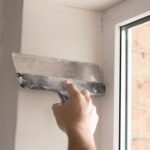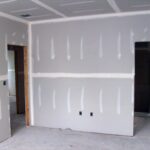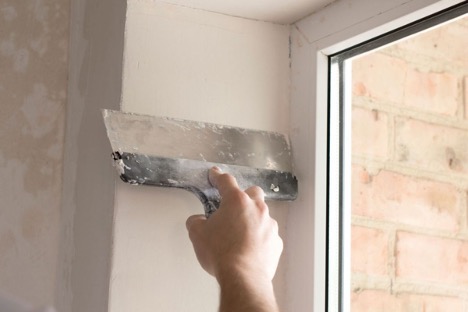How to putty seams on drywall: rules for applying the composition
Seams are the joints of plasterboard sheets; they require putty for subsequent painting. The procedure is carried out in several stages - first prepare the surface, inspect for irregularities and traces of screw heads. Next, you need to understand how to putty the seams on drywall, and what to do next. Instructions for this can be found in our material.
The content of the article
Selection of putty, preparation of tools
When learning the process of how to putty drywall joints, you first need to choose the appropriate mixture and stock up on tools and the necessary materials. You can use any composition – from the most affordable to the most expensive. But not every mixture is suitable for every room.
The choice depends on the degree of humidity and the presence/absence of temperature changes, cooling:
- if this is an ordinary room (for example, a nursery, a bedroom), you can use any mixture;
- if the room has high humidity, gypsum compositions are excluded - in this case it is necessary to consider how to plaster drywall seams with a cement or polymer composition;
- if external work is being carried out, again, gypsum putties are excluded - it is better to use polymer ones, because they create an elastic layer that is resistant to any influences.
Why and how to putty plasterboard corners is quite clear.Such work is carried out in order to hide joints and cracks at the points of contact between plasterboard sheets. This is where they are destroyed most quickly due to contact with moisture, aggressive chemicals and air. Defects can be identified visually - unevenness is noticeable at the joints, spots often appear and color changes.
To eliminate such defects, the corners of the drywall are puttied. To do this you will need the following materials and tools:
- the putty itself;
- serpyanka;
- primer;
- roller (a wide brush can be used instead);
- assembly knife, well sharpened;
- sandpaper with a grater;
- spatulas with clean blades (set);
- drill and mixer attachment;
- screwdriver;
- capacity.
Preparatory work
Before you begin how to putty plasterboard corners, you should carefully clean the rough surface. The work is carried out in several stages:
- Completely clean the sheets of dust.
- Remove burrs and burrs using a sharp knife.
- Carefully (if necessary with a flashlight) determine the position of the screw heads. They should be flush with the surface or slightly (but not too much) recessed into the thickness of the sheet, as shown in the figure. This is one of the basic rules of the instructions on how to properly putty the corners of drywall.
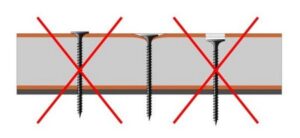
- If the heads of some fasteners protrude, they need to be tightened. If they are recessed, on the contrary, remove them completely. Then screw it in side by side, and fill the resulting hole with putty in the next step.
- When learning how to putty an internal corner of plasterboard, you need to unstitch the joints of the straight ends of the sheets (if there are any). Although if the factory edges touch, as shown in the diagram, cutting is not necessary in this case.
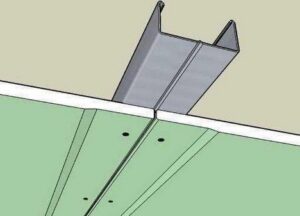
- If the corners are right, they are embroidered diagonally at 45 degrees. It is convenient to use a mounting knife so that the recesses make up approximately two-thirds of the plasterboard sheet. If you have the equipment, you can perform the work with a drill with a cone cutter. Moreover, a lot of dust will appear, so it is important to use a respirator and goggles.
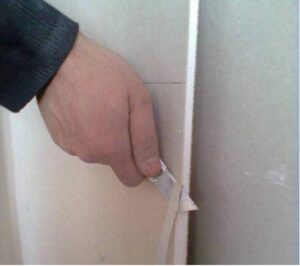
- Before you begin to follow the instructions on how to putty the corners of plasterboard walls, it is also important to treat the surfaces with a primer composition. It must be applied to the entire surface area, extending 15 cm in each direction from the joint.

Putty corners
Now you can start the main work - i.e. figure out when to apply the second layer of putty, and when to apply the first. First, mix the composition, proceeding as follows:
- Pour three-quarters of the required volume of water into the bucket.
- Add putty and stir a little.
- Then add the remaining volume of water in a thin stream.
- Stir with a mixer mounted on a drill for several minutes until the mixture comes together, and in appearance it should resemble thick sour cream.
- Next, the solution needs to swell; 5 minutes is enough for this, after which it is mixed again.
- Then you can immediately begin finishing without allowing the composition to harden. It is better to prepare it in small quantities so that finishing work can only be done with fresh mixture.
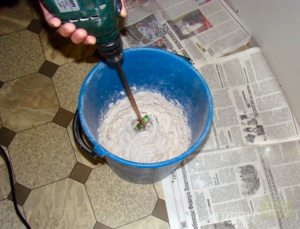
The main way to plaster drywall joints is presented in the following instructions:
- Apply the composition to a spatula with a wide blade and cover the recesses, moving across the joint, i.e. perpendicular. Moreover, the mixture must be literally pressed into the groove, applying a certain force, until it is completely filled.
- Another layer of the mixture is applied over the joint, and its width should approximately correspond to the width of the serpyanka, but at the same time slightly exceed it. This is one of the important requirements for how to properly putty GVP.
- The mesh for reinforcement is embedded in the mixture - it should be completely hidden.
- After this, remove excess parts of the composition and smooth the surface with a spatula.
- When the layer has set, apply a second one - it should completely cover the previous one.
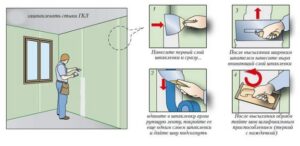
The joints between walls and ceilings can be treated in the same way. But for these works it is better to use a special angular spatula. The layer here will also be quite thick, so you will need a serpyanka, it should be wide enough - at least 10 cm. Instead, you can use plastic corners with perforations.

The last stage is sanding the drywall seams to eliminate all unevenness. You will need a grater with fine-grit sandpaper. You need to work with medium pressure so as not to tear off the wet layer. You should carefully inspect the surface in good lighting, and use a flashlight if necessary. Particular care is taken to remove lumps and remaining solution with adhered particles.
Now it’s clear how to putty the seams on the ceiling, and how to pre-prepare the surface. The work is easy to do and does not require special skills or equipment. It is useful to stock up on a set of spatulas and, if necessary, thoroughly clean their blades. The composition is applied in two layers, after waiting for the first to dry. Then it is sanded, after which you can begin painting or other type of finishing.

